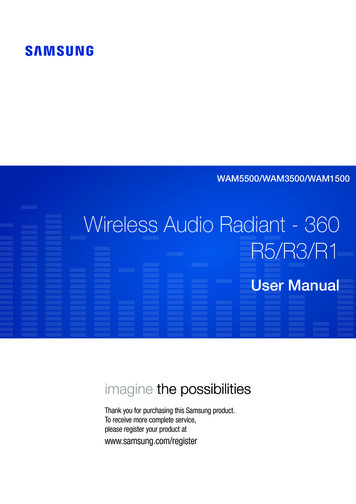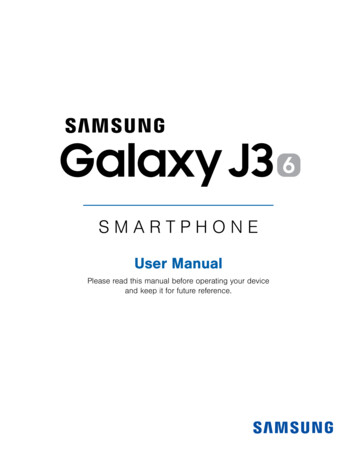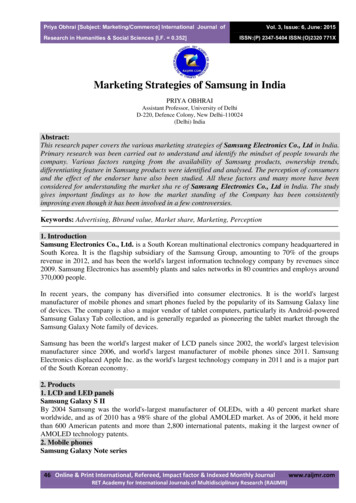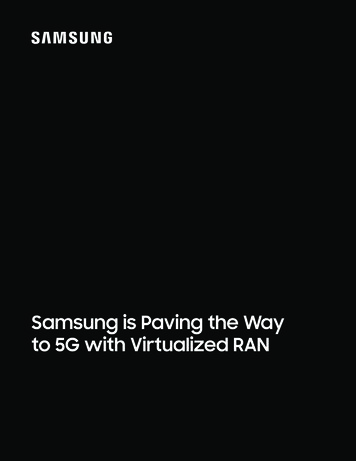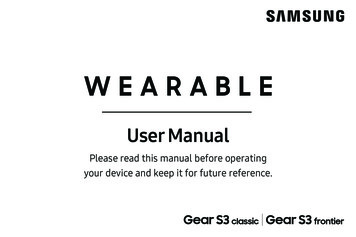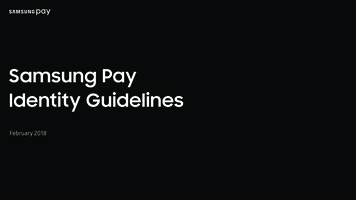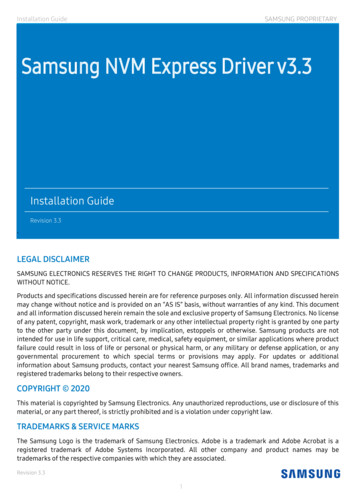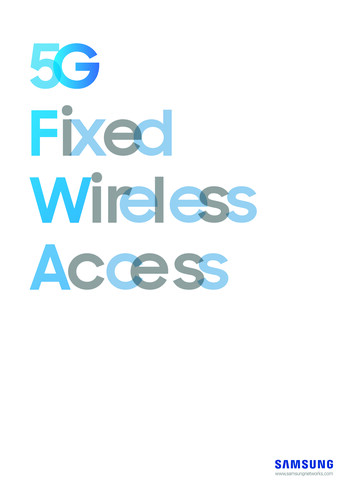
Transcription
Table of Contents1. Introduction.012. 5G FWA Spectrum and Standards. 043. Global Outlook for 5G FWA Services. 05
4. 5G FWA Technical Challenges and Solutions . 075. Samsung End-to-end 5G FWA Solutions . 096. Expanding beyond FWA . 12
01.IntroductionBroadband access is vital to socio-economic development. However, deploying wireline broadband networks requireshigh capital expenditure and mid to long term investment. In particular, few hundred meters of last mile deploymenthas been a major obstacle for wireline broadband technologies. A solution to this time consuming and costly last miledeployment is Fixed Wireless Access (FWA). FWA is an innovative solution which enables easy and rapid deploymentof broadband networks. It allows carriers to meet the increasing demand for high speed broadband services time tomarket and more cost-effectively.FWA solution using LTE or WiMAX has been around for many years but its speed is not nearly as fast as other highspeed broadband solutions such as fiber. Fortunately, with the introduction of 5G and abundant swaths of under-used,high frequency millimeter waves (mmWaves) above 6GHz, the speed of FWA is now comparable to fiber. In addition,technology advancement has made even below 6GHz spectrums more feasible for fixed wireless by applying massiveMIMO technologies. Using below 6GHz band, wider coverage can be achieved which makes it suitable to cover ruralareas.Depending on each operator’s spectrum assets, either or both below and above 6GHz spectrums can be utilized toprovide 5G FWA service as a competitive solution for superfast broadband network.[Concept of 5G Fixed Wireless Access]01
From a technology perspective: A cost-effective last mile solutionPerhaps the most compelling aspect of FWA is its potential to transform the last mile and greatly reduce theburden for Network Service Providers (NSPs) and subscribers alike.Deploying fibre is hard. It requires a significant outlay in terms of time and capital, as well as considerablestrategic planning, understanding of legal frameworks at multiple levels of government and a considerableamount of available labour. Broadly speaking, there are two phases to any localized fibre deployment: the“pass” – in which fibre is laid through or nearby a target neighbourhood or district – and the “drop” – in whichthe fibre is laid down in the “last mile” connecting the “passing” fibre to the subscriber’s home. Regardless ofthe delivery technology chosen – whether VDSL, DOCSIS 3.1 or FTTH – the “pass” is largely unavoidable. Dueto the distances covered and capacities required for backhauling, fibre is really the only option.In reality, it is the “drop” where deployment challenges really take shape. Construction permits, contractedlabour and trench digging need to be arranged on a per sub-scriber basis in order to physically deliver serviceat subscriber homes, and thus these costs cannot be shared.In many markets, operators need to work with national, regional and municipal government at differentstages in order to obtain necessary construction and deployment permits for equipment along the way. Thiswhole process can take days to weeks whereas for FWA it takes only several minutes.By deploying Access Units (AUs – the 5G base station) on utility poles or building rooftops in close proximityto the passing fibre backhaul, a neighbourhood or district can be blanketed with high-density, high-capacity(multi-Gbps) wireless coverage. After activating a subscription, users simply place a 5G customer premisesequipment (CPE, analogous to a DSL or cable modem) in a window near the AU, and they are online instantly.Subscribers can enjoy a broadband experience just as they would with FTTH, without the hassle of paying(and waiting) for a contractor to dig up their front lawn to bury a physical fibre line to their home.02
Additionally, as will be explored later in this paper, this opens up significant new opportunities for operatorsto expand their FWA infrastructure deployments into additional new use cases, by leveraging additional,unused wireless capacity for new services and new devices.Broadly speaking, FWA provides significantly lower barriers to entry into the broadband market as comparedto FTTH, while providing a robust and flexible network access layer to jumpstart future service opportunities.From a market perspective:accelerating the pace of innovation in the wireline broadband marketThe main interest in current 5G FWA has come from the USA. Major US operators such as Verizon and AT&Thave particular reasons to be interested in 5G FWA. About 80% (106M) of the 134M housings units in the UShave access to broadband internet however only 23% of US housings units have access to superfast broadbandnetworks with speeds over 100Mbps. It implies there is a growing needs for higher speed broadband networksand opens the door for new players. With 5G FWA, the high cost of entry into the market would no longer be anobstacle for new entrants and the technology could help bridging the digital divide.03
02.FWA Spectrum and Standards28 GHz Spectrum to Lead Early FWA DeploymentsFor decades mobile networks had been confined to a relatively narrow band of the radio spectrum generallybetween 600MHz and 2600MHz – a total space of about 2GHz.Hence at least for the short-term, sub-6 GHz spectrum deployment remains an unfeasible concept for FWAdue to bandwidth insufficiency. The mobile industry has turned its head to find a new territory and the mostdiscussed “above 6 GHz band” for 5G today is 28GHz – which has been permitted for use in the US and SouthKorea. The spectrum has emerged as the preferred band for the very first deployments of 5G-based FWAnetworks. However, other options such as 26 GHz and 39GHz that are discussed primarily in Europe and the USrespectively – are also being actively explored.Many countries such as the US, Europe, Korea, and Japan have recently announced their 5G spectrum strategies,showing that the year 2018-2020 is the right time for 5G commercial systems deployments using mmWave bands.In line with this, it is expected that 5G commercial services be initiated with FWA in the US.In the US, it has been announced by FCC that its policy and technical regulation (July 2016) outline the use of 28GHz (27.5-28.35GHz), 37GHz (37-38.6 GHz) and 39GHz (38.6-40 GHz) for 5G. FCC Chairman Ajit Pai said he wantsto hold an auction for 28 GHz spectrum in November 2018.On the other hand, in Europe, EC has announced that the 26GHz (24.25-27.5 GHz) band is to be labeled as the“pioneer bands” for 5G in November 2016. In particular, UK’s Ofcom has proposed that it will release its upperband (26.5 27.5GHz) prior to WRC’19, during their Call for Input 2017. Ofcom confirmed that it will commence anauction of 150 MHz of spectrum in the 3.4 GHz band for future 5G mobile services on Mar 20, 2018.South Korea has completed auctioning off 5G spectrums on June 18, 2018. 280MHz bandwidth of 3.5GHzspectrum and 2400MHz of 28GHz spectrum were given to three operators. SK Telecom and KT each won 100MHzof the 3.5GHz spectrum, while LG Uplus clinched 80MHz. All three telcos secured 800MHz of the 28GHzspectrum. In Japan, MIC has published its final report on the 2020 Japan Radio Policy in July 2016 with aspecific regard to their 5G candidate spectrum bands, including the 28 GHz band to be used for 5G commercialservices realization in 2020.As for other parts of the world, IMDA of Singapore, MIIT of China and ISED of Canada have all released their publicconsultation papers in 2017 to acquire industry perspectives on 5G spectrums, including 28 GHz.FCC : Federal Communications Commission, EC : European Commission, MSIP : Ministry of Science and ICTMIC : Ministry of Internal Affairs and Communications, IMDA : Info-communications Media Development AuthorityMIIT : Ministry of Industry and Information Technology, ISED : Innovation, Science and Economic Development04
03.3. Global Outlook for 5G FWA Services5G FWA Subscriptions and CPE unit shipments by regionAccording to SNS Telecom, North America will be a benchmark for fast growing 5G FWA market in aspects ofsubscriptions and unit shipments. In 2030, the total number of 5G FWA subscriber will be almost 345 millionand there will be 200 million subscriptions in North America.(Source : SNS Telecom)In the U.S., Verizon has rolled out its pre-standards 5G network footprint across 11 cities for trials of a FWAservice. Verizon has announced its intentions to fully commercialize this offering as early as 2018. AT&T, also, isoffering a 5G-based FWA service to select participants in residential, small business and enterprise locations,initially in Austin, Texas. As of Q3’2017, AT&T is expanding its trials to target both fixed and mobile applications,intended to track closely with the first 3GPP 5G NR specification. To help speed up its 5G rollout plans, theoperator has successfully lobbied the 3GPP to finalize part of the 5G NR standard earlier in Q4’2017, instead ofQ2’2018. While many industry analysts believe that 5G FWA is only suitable for densely populated urban areas,a number of rural carriers – including C Spire and U.S. Cellular – are beginning to view 5G as a means to deliverlast-mile broadband connectivity to underserved rural communities. SNS Research expects that 5G-based FWACPE unit shipments will grow at a CAGR of more than 57% between 2019 and 2025, eventually accounting forover 25 million unit shipments by the end of 2025. They expect these device unit shipments to generate nearly 4billion in sales revenue. Broadband internet access for both residential and business environments is the primaryapplication scenario for 5G-based FWA.SNS Telecom expects that 5G-based FWA CPE unit shipments will grow at a CAGR of more than 57% between2019 and 2025, eventually accounting for over 25 Million unit shipments by the end of 2025. They expect thesedevice unit shipments to generate nearly 4 Billion in sales revenue.05
(Source : SNS Telecom)Service RevenueBroadband internet access for both residential and business environments is the primary application scenariofor 5G-based FWA.(Source : SNS Telecom)06
04.FWA Technical Challenges and SolutionsTechnical ChallengesThe primary challenges with Fixed Wireless Access lie predominantly within the spectrum being used. In orderto deliver a compelling alternative to today’s wireline broadband, wireless solutions need to be able to meetcapacity and throughput demands in line with common expectations for FTTH-type services. Due to the verylimited availability of spectrum below 3GHz, mmWave (above 20GHz) remains the ideal target for FWA-typesolution, and in turn, this means that we need new technology and tools to plan and deploy around thelimitations of high frequency radio signals.From Samsung’s trial efforts throughout 2016 and 2017, the primary challenges identified include deploymentswith non-ideal line of sight conditions, high density tree foliage and certain types of glass designed to reducethermal radiation (often referred to as low-emissivity, or low-e glass). In all cases, the primary consequence isgreatly reduced signal quality, leading to significantly lower-than-expected throughputs and consequently apoor user experience.Technical SolutionsIn order to overcome these challenges, Samsung has developed several key solutions that have demonstrated ahigh degree of success, greatly improving the viability ofmmWave for high-throughput FWA applications.First, Samsung has developed a technology called‘beamforming’, in which we use advanced signalprocessing to physically shape the radio signal into atight, flashlight-like beam that accurately targets eachindividual device. This allows us to confine the radiooutput energy into a small area, significantly extendingthe range and penetration capability of mmWavesignals.A stronger, confined signal can better penetrate foliage,and allows for clever manipulation of the beam, such asbouncing it off of surfaces in the environment to reachdevices that don’t have direct line-of-sight with the AU.07
Second, in order to accurately simulate beam patterns incomplex environments, Samsung has developed a specializedRF Planning software tool. The RF Planing tool is especiallyimportant in Fixed Wireless Access service because operatorscan easily identify 5G service availability in each geographicarea. This can potentially save costs associated withdispatching technicians to areas with poor service availability bynot subscribing customers in those areas and avoid customerdisappointment.Samsung will take map data of an environment from multiplesources including overhead satellite maps, 3D building mapsand 360 street-level photography, stitch them together into aunified ‘semantic map’, and then use artificial intelligence toaccurately simulate how mmWave radio signals perform andreact with the environment.The tool uses machine learning to identify trees in theenvironment, building geometry and construction materials,and then uses ray tracing technology to simulate within amatter of minutes how radio beams bounce around theenvironment and reach potential devices.3D RF planing toolThe tool replaces traditional drive testing methods, in which network planners physically drive through eachneighborhood with expensive radio testing equipment – a labor-intensive process that can take days for a givenneighborhood.And last, in order to resolve situations where coverage cannot suitably be provided to a user’s in-home5G CPCPE (for example, if the only suitable window is not facing to the Access Unit, or a building or streetfurniture blocks ideal beam pathing), additional form-factor options are available, including an outdoor 5G CPE.A ruggedized, all-weather outdoor CPE can be flexibly deployed on a building roof or mounted to ex
According to SNS Telecom, North America will be a benchmark for fast growing 5G FWA market in aspects of subscriptions and unit shipments. In 2030, the total number of 5G FWA subscriber will be almost 345 million and there will be 200 million subscriptions in North America.



